Related Research Articles

Juan Bautista de Anza Bezerra Nieto was an expeditionary leader, military officer, and politician primarily in California and New Mexico under the Spanish Empire. He is credited as one of the founding fathers of Spanish California and served as an official within New Spain as Governor of the province of New Mexico.

Mission San Juan Bautista is a Spanish mission in San Juan Bautista, San Benito County, California. Founded on June 24, 1797, by Father Fermín Lasuén of the Franciscan order, the mission was the fifteenth of the Spanish missions established in present-day California. Named for Saint John the Baptist, the mission is the namesake of the city of San Juan Bautista.
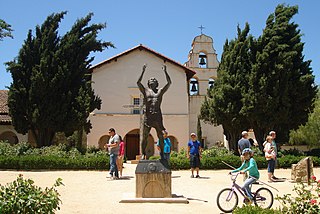
San Juan Bautista is a city in San Benito County, in the U.S. state of California. The population was 2,089 as of the 2020 census. San Juan Bautista was founded in 1797 by the Spanish under Fermín de Lasuén, with the establishment of Mission San Juan Bautista. Following the Mexican secularization of 1833, the town was briefly known as San Juan de Castro and eventually incorporated in 1896. Today, San Juan is a popular tourist destination, as the home of the San Juan Bautista State Historic Park and other important historic sites, as well as cultural institutions like El Teatro Campesino.
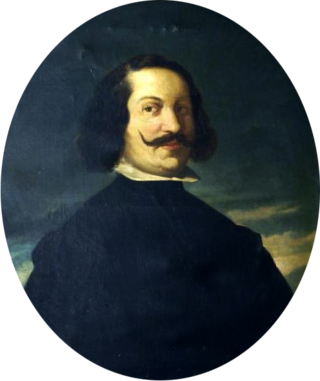
Juan de Valdés Leal was a Spanish painter and etcher of the Baroque era.

Juan Bautista de Espinosa (1590–1641) was a Spanish painter. Much of his work, which included religious paintings and portraits, is now untraced, and his few known extant paintings are all still lifes.
Events from the year 1569 in art.
Events from the year 1590 in art.

Friar Juan Bautista Maíno, or Mayno was a Spanish Baroque painter.

Friar Juan Andrés Ricci de Guevara, known as Friar Juan Rizi was a Spanish Benedictine monk, painter, and architect, in the Baroque style. He also wrote works on theology and geometry and may have been nominated to become a bishop.
Juan Bautista Ravanals (1678-?) was a Spanish engraver. He was born at Valencia. He studied under Evaristo Muñoz. He engraved an equestrian portrait of King Philip V of Spain and a genealogical tree of the royal family; a portrait of Father Gregorio Ridaura, a print of San Rodrigo, a second portrait of Philip V., some plates for the first edition of a mathematical work by Tosca, the frontispiece for a book called Centro de la Fe Ortodoxa, which represents the apparition of Our Lady del Pilar to St. Francis and some of his disciples, and illustrations for another book of Devotion, in which St. Thomas Aquinas and other saints figure.

Tomás de Aguiar was a Spanish painter, active during the Baroque period. He was a pupil of Diego Velázquez, and known for painting portraits.
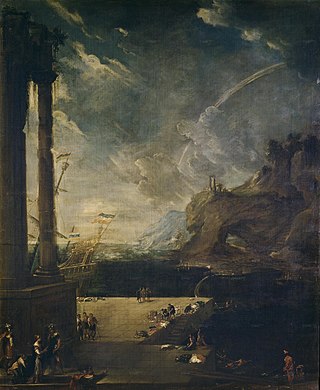
Benito Manuel Agüero (1624–1668) was a Spanish painter of the Baroque period, active mainly in Madrid as a landscape and battle painter.
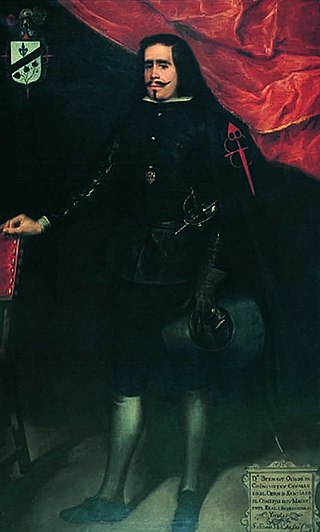
Juan de Alfaro y Gámez (1643–1680) was a Spanish painter of the Baroque. He was born at Córdoba. He was first a pupil of Antonio del Castillo, but finished his studies at Madrid under Velázquez, whose manner he followed, particularly in portraits. He was employed by Velazquez in copying the works of Titian, Rubens, and Van Dyck. In the church of the Carmelites is an Incarnation and in the church of the Imperial College at Madrid is his picture of the Guardian Angel.
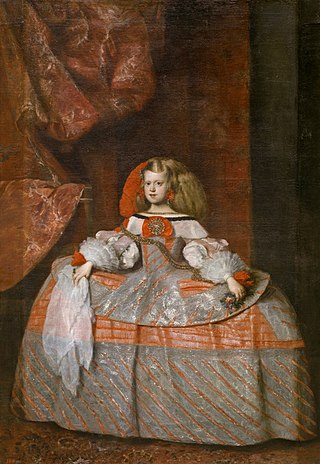
Infanta Margarita Teresa in a Pink Dress is a 1660 oil on canvas portrait of Margaret Theresa of Spain by the Spanish painter Diego Velázquez, though his identification as its author is not considered secure. It is now in the Prado Museum in Madrid.

Juan García de Miranda (1677–1749), was a Spanish painter of the baroque period, a disciple of Juan Delgado and the uncle of Pedro Rodríguez de Miranda. He was appointed Painter to the King.

Juan de la Corte, a Spanish painter of Flemish origin, who was born in Antwerp, Flanders in c. 1590. He was instructed by Velazquez, and painted portraits and history, but chiefly excelled in battle-pieces and perspective views. He also painted small pictures of subjects from sacred history. He was painter to King Phillip III, and was continued in that situation by his successor, King Philip IV. There are several of his pictures in the palace of Buen Retiro. He died at Madrid in 1660.

Juan GalvánJiménez, a Spanish painter, was born at Luesia, in the kingdom of Aragon. According to Palomino, he went to Rome for improvement, where he remained some time, and on his return to Spain in 1624 resided chiefly at Zaragoza, where he was named painter by the Corporation, and executed various pictures for the cathedral and Carmelite convent. For the cathedral of Zaragoza he executed pictures of the Nativity,Santa Justa, and Santa Rufina, as well as other large works, which Cean Bermudez praises for their colouring. He painted the cupola of Santa Justa y Rufina, and a picture of the Trinity for the Barefooted Carmelites; but his principal work was the Birth of the Virgin. He died at Zaragoza.
The 2013 Valencia Open 500 was a men's tennis tournament played on indoor hard courts. It was the 19th edition of the Valencia Open, and part of the 500 Series of the 2013 ATP World Tour. It was held at the Ciutat de les Arts i les Ciències in Valencia, Spain, from 21 October through 27 October 2013. Unseeded Mikhail Youzhny won the singles title.

The Conversion of St. Paul is a 1614 painting by Juan Bautista Maíno, located in the collection of the National Museum of Art of Catalonia (MNAC).
References
 This article incorporates text from a publication now in the public domain : Bryan, Michael (1886). "Bayuco, Juan Bautista". In Graves, Robert Edmund (ed.). Bryan's Dictionary of Painters and Engravers (A–K). Vol. I (3rd ed.). London: George Bell & Sons.
This article incorporates text from a publication now in the public domain : Bryan, Michael (1886). "Bayuco, Juan Bautista". In Graves, Robert Edmund (ed.). Bryan's Dictionary of Painters and Engravers (A–K). Vol. I (3rd ed.). London: George Bell & Sons.